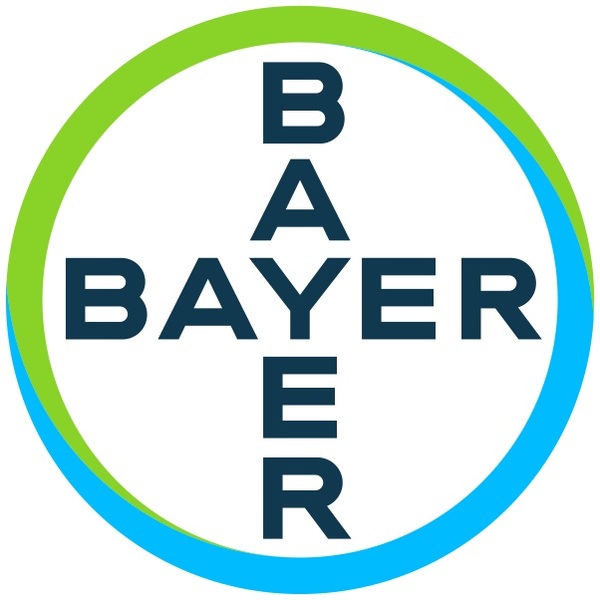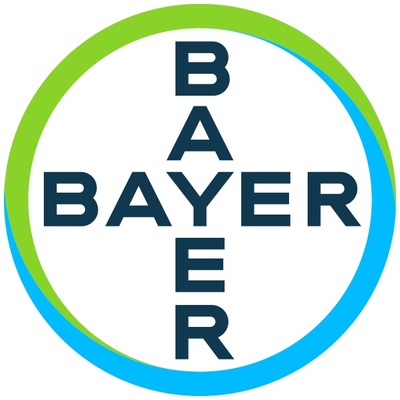


WHIPPANY, N.J., March 22, 2017 /PRNewswire/ -- Bayer announced today that the latest research from its growing oncology portfolio will be presented at the American Association for Cancer Research (AACR) 2017 Annual Meeting, taking place on April 1-5 in Washington, D.C. These presentations reflect the company's diverse pipeline, with findings from clinical and preclinical studies in a variety of hematologic and solid cancers.

Among these data are clinical results from the Phase II CHRONOS-1 trial evaluating copanlisib in patients with relapsed or refractory indolent non-Hodgkins lymphoma (iNHL), which will be presented for the first time as part of the Congress' Clinical Trials Minisymposia. Also scheduled are a series of preclinical data presentations including a number of small molecules, such as regorafenib, the pan-fibroblast growth factor receptor (FGFR) inhibitor BAY 1163877, the positive transcription elongation factor (PTEFb) inhibitor BAY 1251152 and the ataxia telangiectasia rad3-related protein (ATR) inhibitor BAY 1895344. In addition, data on Bayer's antibody-drug conjugate (ADC) platform will be presented, including the C4.4A-ADC BAY1129980 and the FGFR2-ADC BAY 1187982, as well as data on three new chemical entities from Bayer's emerging Targeted Thorium Conjugate (TTC) platform, which carry an alpha-particle emitting payload as a toxophore. Preclinical results of radium-223 dichloride will also be presented.
The following list comprises a selection of presentations on Bayer pipeline projects presented at AACR 2017.
Oral Presentations
Selected Poster Presentations
About Copanlisib
Copanlisib is a pan-class I phosphatidylinositol-3-kinase (PI3K) inhibitor with predominant inhibitory activity against both PI3K-α and PI3K-δ isoforms. The PI3K pathway is involved in cell growth, survival and metabolism, and its dysregulation plays an important role in NHL. Preclinically, copanlisib has been shown to inhibit both PI3K-δ and PI3K-α isoforms at sub-nanomolar concentrations.
Copanlisib is an investigational compound developed by Bayer. The efficacy and safety of copanlisib has not been established. The clinical development program for copanlisib currently consists of Phase II and Phase III studies in indolent and aggressive NHL. Information about these trials can be found at www.clinicaltrials.gov and www.chronostrials.com.
Copanlisib is not approved by the U.S. Food and Drug Administration, the European Medicines Agency or any other health authority.
About Stivarga® (regorafenib)
In the United States, Stivarga is indicated for the treatment of patients with metastatic colorectal cancer (CRC) who have been previously treated with fluoropyrimidine-, oxaliplatin- and irinotecan-based chemotherapy, an anti-VEGF therapy, and, if RAS wild type, an anti-EGFR therapy. It is also indicated for the treatment of patients with locally advanced, unresectable or metastatic gastrointestinal stromal tumor (GIST) who have been previously treated with imatinib mesylate and sunitinib malate.1
Important Safety Information for Stivarga® (regorafenib) tablets:
|
WARNING: HEPATOTOXICITY |
|
|
Hepatotoxicity: Severe drug-induced liver injury with fatal outcome occurred in STIVARGA-treated patients across all clinical trials. In most cases, liver dysfunction occurred within the first 2 months of therapy and was characterized by a hepatocellular pattern of injury. In metastatic colorectal cancer (mCRC), fatal hepatic failure occurred in 1.6% of patients in the STIVARGA arm and in 0.4% of patients in the placebo arm. In gastrointestinal stromal tumor (GIST), fatal hepatic failure occurred in 0.8% of patients in the STIVARGA arm.
Liver Function Monitoring: Obtain liver function tests (ALT, AST, and bilirubin) before initiation of STIVARGA and monitor at least every 2 weeks during the first 2 months of treatment. Thereafter, monitor monthly or more frequently as clinically indicated. Monitor liver function tests weekly in patients experiencing elevated liver function tests until improvement to less than 3 times the upper limit of normal (ULN) or baseline values. Temporarily hold and then reduce or permanently discontinue STIVARGA, depending on the severity and persistence of hepatotoxicity as manifested by elevated liver function tests or hepatocellular necrosis.
Hemorrhage: STIVARGA caused an increased incidence of hemorrhage. The overall incidence (Grades 1-5) was 21% and 11% with STIVARGA vs 8% and 3% with placebo in mCRC and GIST patients, respectively. Fatal hemorrhage occurred in 4 of 632 (0.6%) STIVARGA-treated patients and involved the respiratory, gastrointestinal, or genitourinary tracts. Permanently discontinue STIVARGA in patients with severe or life-threatening hemorrhage and monitor INR levels more frequently in patients receiving warfarin.
Dermatological Toxicity: STIVARGA caused an increased incidence of hand-foot skin reaction (HFSR) (also known as palmar-plantar erythrodysesthesia [PPE]) and severe rash, frequently requiring dose modification. The overall incidence was 45% and 67% with STIVARGA vs 7% and 12% with placebo in mCRC and GIST patients, respectively. Incidence of Grade 3 HFSR (17% vs 0% in mCRC and 22% vs 0% in GIST), Grade 3 rash (6% vs <1% in mCRC and 7% vs 0% in GIST), serious adverse reactions of erythema multiforme (0.2% vs 0% in mCRC), and Stevens-Johnson syndrome (0.2% vs 0% in mCRC) was higher in STIVARGA-treated patients. In both studies, a higher incidence of HFSR was observed in Asian patients treated with STIVARGA (all grades: 78.4% in mCRC and 88.2% in GIST and Grade 3: 28.4% in mCRC and 23.5% in GIST). Toxic epidermal necrolysis occurred in 0.17% of 1200 STIVARGA-treated patients across all clinical trials. Withhold STIVARGA, reduce the dose, or permanently discontinue depending on the severity and persistence of dermatologic toxicity.
Hypertension: STIVARGA caused an increased incidence of hypertension (30% vs 8% in mCRC and 59% vs 27% in GIST with STIVARGA vs placebo, respectively). Hypertensive crisis occurred in 0.25% of 1200 STIVARGA-treated patients across all clinical trials. Do not initiate STIVARGA until blood pressure is adequately controlled. Monitor blood pressure weekly for the first 6 weeks of treatment and then every cycle, or more frequently, as clinically indicated. Temporarily or permanently withhold STIVARGA for severe or uncontrolled hypertension.
Cardiac Ischemia and Infarction: STIVARGA increased the incidence of myocardial ischemia and infarction in mCRC (1.2% with STIVARGA vs 0.4% with placebo). Withhold STIVARGA in patients who develop new or acute cardiac ischemia or infarction, and resume only after resolution of acute cardiac ischemic events if the potential benefits outweigh the risks of further cardiac ischemia.
Reversible Posterior Leukoencephalopathy Syndrome (RPLS): RPLS occurred in 1 of 1200 STIVARGA-treated patients across all clinical trials. Perform an evaluation for RPLS in any patient presenting with seizures, severe headache, visual disturbances, confusion, or altered mental function. Confirm the diagnosis of RPLS with MRI and discontinue STIVARGA in patients who develop RPLS.
Gastrointestinal Perforation or Fistula: Gastrointestinal perforation or fistula occurred in 0.6% of 1200 patients treated with STIVARGA across clinical trials. In GIST, 2.1% (4/188) of STIVARGA-treated patients developed gastrointestinal fistula or perforation: of these, 2 cases of gastrointestinal perforation were fatal. Permanently discontinue STIVARGA in patients who develop gastrointestinal perforation or fistula.
Wound Healing Complications: Treatment with STIVARGA should be stopped at least 2 weeks prior to scheduled surgery. Resuming treatment after surgery should be based on clinical judgment of adequate wound healing. STIVARGA should be discontinued in patients with wound dehiscence.
Embryo-Fetal Toxicity: STIVARGA can cause fetal harm when administered to a pregnant woman. There are no available data on STIVARGA use in pregnant women. Advise pregnant women of the potential risk to a fetus. Advise females of reproductive potential and males with female partners of reproductive potential to use effective contraception during treatment with STIVARGA and for 2 months after the final dose.
Nursing Mothers: Because of the potential for serious adverse reactions in breastfed infants from STIVARGA, do not breastfeed during treatment with STIVARGA and for 2 weeks after the final dose.
Most Frequently Observed Adverse Drug Reactions in mCRC (≥30%): The most frequently observed adverse drug reactions (≥30%) in STIVARGA-treated patients vs placebo-treated patients in mCRC, respectively, were: asthenia/fatigue (64% vs 46%), decreased appetite and food intake (47% vs 28%), HFSR/PPE (45% vs 7%), diarrhea (43% vs 17%), mucositis (33% vs 5%), weight loss (32% vs 10%), infection (31% vs 17%), hypertension (30% vs 8%), and dysphonia (30% vs 6%).
Most Frequently Observed Adverse Drug Reactions in GIST (≥30%): The most frequently observed adverse drug reactions (≥30%) in STIVARGA-treated patients vs placebo-treated patients in GIST, respectively, were: HFSR/PPE (67% vs 12%), hypertension (59% vs 27%), asthenia/fatigue (52% vs 39%), diarrhea (47% vs 9%), mucositis (40% vs 8%), dysphonia (39% vs 9%), infection (32% vs 5%), decreased appetite and food intake (31% vs 21%), and rash (30% vs 3%).
For important risk and use information, please see the full Prescribing Information, including the Boxed Warning.
You are encouraged to report negative side effects or quality complaints of prescription drugs to the FDA. Visit www.fda.gov/medwatch or call1-800-FDA-1088.
About Xofigo® (radium Ra 223 dichloride) Injection
Xofigo is indicated for the treatment of patients with castration-resistant prostate cancer, symptomatic bone metastases and no known visceral metastatic disease.2
Important Safety Information for Xofigo® (radium Ra 223 dichloride) Injection
For full Prescribing Information
visit http://labeling.bayerhealthcare.com/html/products/pi/Xofigo_PI.pdf.
About Oncology at Bayer
Bayer is committed to delivering science for a better life by advancing a portfolio of innovative treatments. The oncology franchise at Bayer includes three oncology products and several other compounds in various stages of clinical development. Together, these products reflect the company's approach to research, which prioritizes targets and pathways with the potential to impact the way that cancer is treated.
Bayer: Science For A Better Life
Bayer is a global enterprise with core competencies in the Life Science fields of health care and agriculture. Its products and services are designed to benefit people and improve their quality of life. At the same time, the Group aims to create value through innovation, growth and high earning power. Bayer is committed to the principles of sustainable development and to its social and ethical responsibilities as a corporate citizen. In fiscal 2016, the Group employed around 115,200 people and had sales of EUR 46.8 billion. Capital expenditures amounted to EUR 2.6 billion, R&D expenses to EUR 4.7 billion. These figures include those for the high-tech polymers business, which was floated on the stock market as an independent company named Covestro on October 6, 2015. For more information, go to www.bayer.us.
# # #
© 2017 Bayer
BAYER, the Bayer Cross, Xofigo and Stivarga are registered trademarks of Bayer.
Forward-Looking Statement
This news release may contain forward-looking statements based on current assumptions and forecasts made by Bayer Group or subgroup management. Various known and unknown risks, uncertainties and other factors could lead to material differences between the actual future results, financial situation, development or performance of the company and the estimates given here. These factors include those discussed in Bayer's public reports which are available on the Bayer website at www.bayer.com. The company assumes no liability whatsoever to update these forward-looking statements or to conform them to future events or developments.
1. STIVARGA® (regorafenib) [Prescribing Information]. Whippany, NJ: Bayer HealthCare Pharmaceuticals, August 2016.
2. XOFIGO® (radium Ra 223 dichloride) [Prescribing Information]. Wayne, NJ: Bayer HealthCare Pharmaceuticals, March 2016.
PP-860-US-0054
Intended for U.S. Media Only
SOURCE Bayer